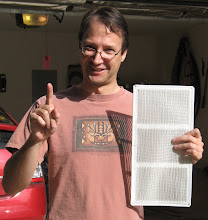Late in 2007, in my travels on the Web researching energy efficiency opinions, I began to run across a lot of information about something called a "radiant barrier". This was something new to me: a type of insulation that wasn't traditional insulation, and said to stop heat flow in a somehow different, and possibly better way than traditional insulation.
To understand the radiant barriers, we need to upgrade our knowledge about how heat actually flows into a home in the summer, or out of a home in the winter. As I understand the mechanics of the situation (nice explanation here), there are 3 ways that heat flows from a hot area to a cooler area: conduction, convection, and radiation.
Conduction refers to heat flowing through a solid material (such as from the outside face of a brick wall to the inside face), and can be reduced by using materials such as fiberglass insulation that conduct heat poorly; that is, heat only moves slowly through them.
Convection refers to heat moving due to the material (a gas or liquid) flowing through space. This type of heat movement can be reduced by trapping the gas or liquid so that it can't move. In fact, part of how fiberglass insulation works is through trapping air in tiny pockets.
Bear with me, intrepid readers: here is the good part. Radiation refers to the transmission of energy through space by means of photons. Those photons, given off by all hot objects in all directions, travel through the air until they hit something solid, whereupon that solid object absorbs their energy and heats up. If you have ever stood in the sun on a clear day, you have felt the radiation of the sun. If you have ever sat outside at a restaurant with heat lamps, you have felt the radiation of the lamps. That radiation was absorbed into your skin, causing your skin to heat up pleasantly.
At this point, an aside may be in order. For the purposes of Energy Efficiency we are talking about infrared radiation, a certain range of wavelengths of radiation, which is a different range of wavelengths than ultraviolet radiation, the harmful-to-your-skin variety of radiation also put out by our sun.
The savvy reader will have already guessed that "radiant barrier" must refer somehow to the blocking of the radiation mechanism of heat transfer. The savvy reader would, in fact, be correct. A radiant barrier is simply a way of reflecting the energy being radiated by photons through the air, rather than absorbing it.
"But how important can that really be?", the questioning reader might ask. "How much energy entering a house in the summer, or leaving it in the winter, is in the form of photons radiating through space?"
The answer, according to the radiant barrier folks, is a lot. Their numbers: over 90% of the heat gain in the summer comes through as radiant heat. Over 50% of the heat loss in the winter goes out as radiant heat. In short, if you aren't doing something about the radiant heat, you are missing most of the ballgame.
Perhaps at this point, you the intelligent reader is asking, "but isn't my insulation already catching those photons? Don't they travel until they hit something solid, like my house, and then become heat inside a material subject to the rules of conduction?"

And again, you would be correct. In the summer, the radiated energy of the sun is striking the roof of your house. For most houses, only a small percentage is reflected; the rest of the energy is absorbed and becomes heat trapped in your roof (shingles, etc.) At that point, your roof is also emitting photons since it is hot, and about half of those travel down through your attic airspace and strike your insulation, imparting their energy to it, which means, heating it up. At that point, the insulation does its conductive-resistance magic to keep the heat flowing more slowly into your ceiling, but make no mistake: that heat is indeed flowing into your ceiling. From there, some of it is convecting into the inside air, and some of it is being radiated as photons which will strike you, heating you up, and strike objects in your home, heating them up.
In the winter, this picture is reversed. Warm objects in your house (yourself, your furniture, your floor, your walls) radiate photons in all directions, removing energy (heat) from yourself and your surroundings and taking that energy outward in all directions, including up. Some of the ones hitting the walls and ceiling will reflect back, reducing the heat loss everywhere except at the windows; by design, the photons mostly go right through glass. The photons that go up and are not reflected strike your ceiling, which they heat up, and the heat begins to flow via conduction through the ceiling, through the insulation, and into the cold attic where it will either be lost to convection with the cold attic air, or radiation up to the roof and through that, again via conduction, to the outside face of the roof, and from there, radiated out into space.
Think well on these scenarios, adventurers, and be rewarded with a whole new arena of possible energy savings...


No comments:
Post a Comment